New Boston Historical Society
New Boston, New Hampshire
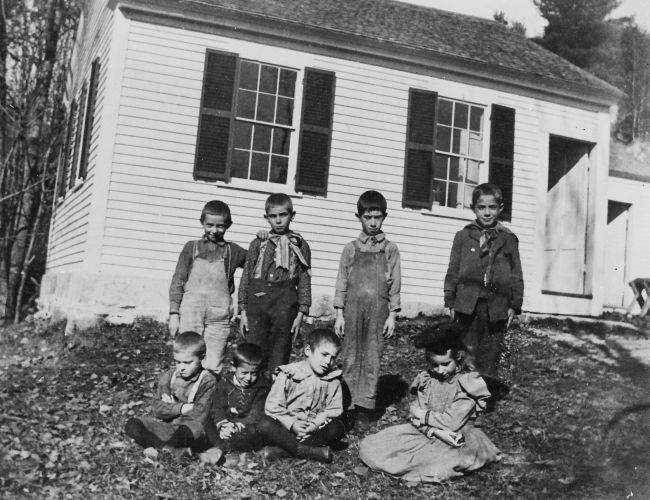
District School #4 - "Joe English" Schoolhouse
From One-Room School Houses to the Village School
Question: Why did New Boston have so many schools? (Raise your hand if you know the answer.)
By 1898 the number of district schoolhouses had dwindled to nine, and by 1935 all New Boston students attended a single three-story Village School in the center of town.
Question: Why did the eighteen District Schools close?
Question: What was it like to be a student or a teacher in a one-room school house?
We'll answer all of these questions before the school bell rings for recess!
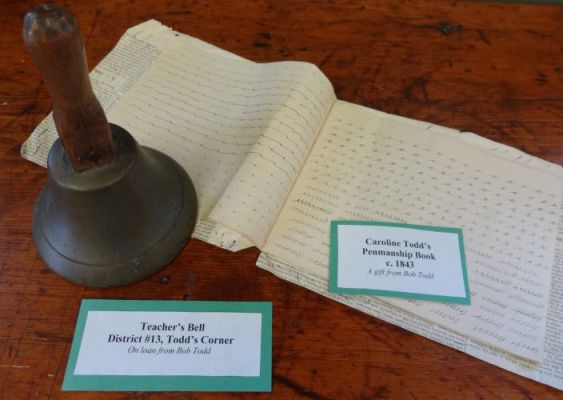
Teacher's Bell and Penmanship Book from Schoolhouse #13 - Todd's Corner
The first school in New Boston was a "Session House" built in 1769 adjacent to the town meetinghouse. This was located in what is now the cemetery above Meetinghouse Hill Road. Seeing that children from the more distant farms could not attend school daily, in 1773 the selectmen employed a teacher who travelled to five different parts of town and taught for a few months in each district. New Boston is six miles square, and it was not practical for small children to walk three or four miles to school over muddy or snow-covered roads.
Ellliott Cogswell wrote in his History of New Boston: "As early as 1788, the town voted to 'hire a grammar-school master for a year, as cheap as they can.'"
Then in 1792, eleven school districts were formed as the population of New Boston grew, and one-room schoolhouses appeared all over town. Here's a map showing all of the schoolhouse locations in 1858:
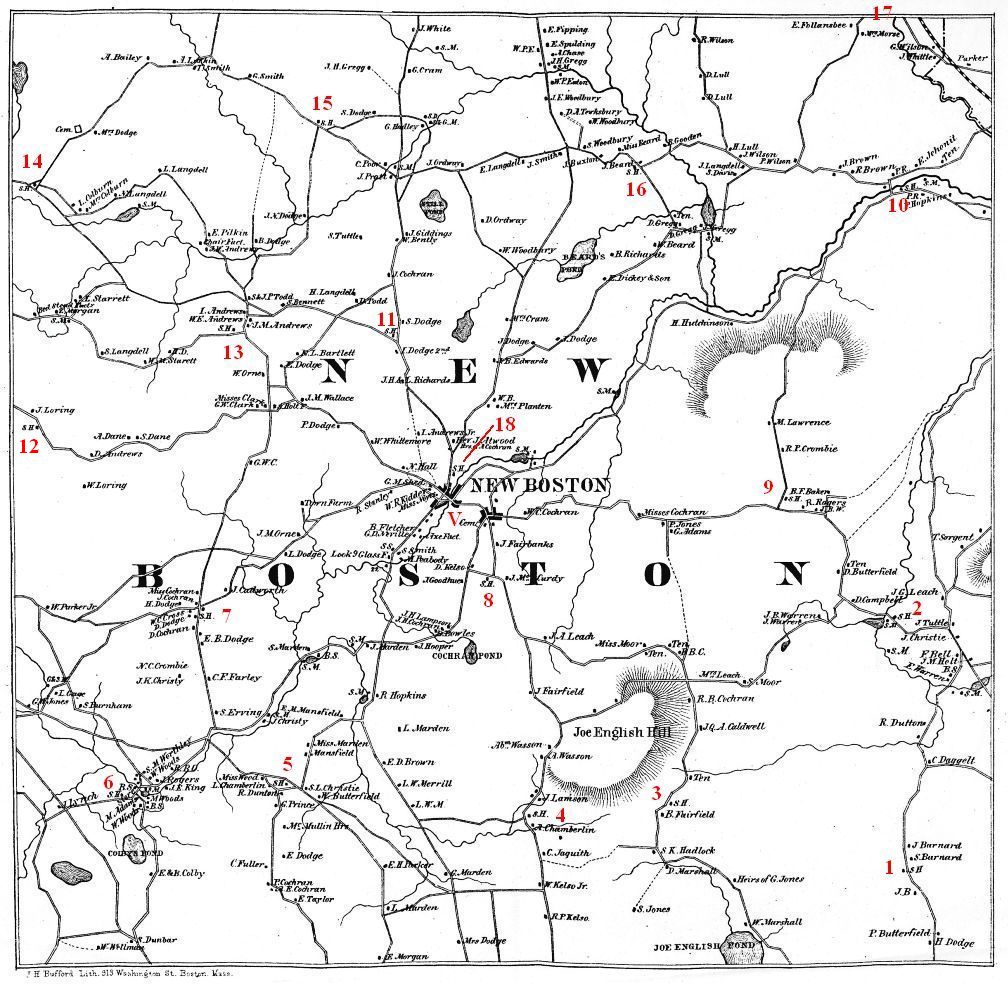
1858 Map of New Boston showing the location of District Schoolhouses
Don't confuse S.H. (School House) with S.M. (Saw Mill) on this map!
| 1. Chestnut Hill | 2. Bedford Road | 3. Sevilla Jones | 4. Joe English | 5. South Hill |
| 6. Gougeville | 7. Cochran Hill | 8. Bradford Lane? | 9. Wilson Hill | 10. Howe Bridge |
| 11. Francestown Road | 12. Clark Hill | 13. Todd's Corner | 14. Bunker Hill Road | 15. Saunder's Hill |
| 16. Lull Road | 17. Riverdale | 18. High Street? | V. Village School |
Going to school in a one-room schoolhouse
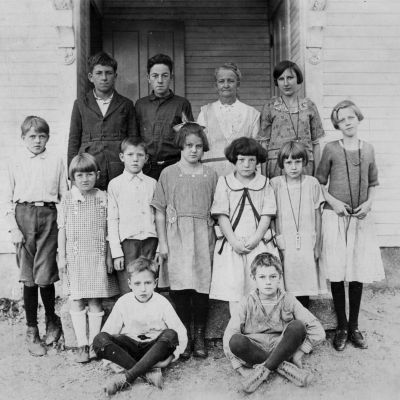
Schoolhouse #13 at Todd's Corner 1924-1925
Jennie Colburn (back row) was older than the typical schoolteacher.
"You took off your boots, hung up your coat, and left your lunch pail. From the front hall you entered a door into one large room. The seats were about six across and six to eight deep. The front seats were small and the largest seats were in the back of the room. The first graders sat in the front row and then there would be second, third, fourth and fifth. By the time you were in the eighth grade you would be in the last row.
"In the back of the room was a wood stove and there was a door that went out to the wood shed. Here you would find two outhouses, one for the girls and one for the boys. The teacher took charge of the stove during the day and locked up after school. Most always she had 'room and board' at the Todd farmhouse across the road. In those days you couldn't teach after you got married.
"The teacher taught all eight grades, and would divide up the classes like first and second, third, fourth, and fifth, then seventh and eighth, and spend about 30 minutes with each group. She would use different corners of the room for each class."
Winston wrote "At the Todd's Corner one-room school, there was a wood stove in the back of the room, but it was a large room with high ceilings. If the daytime temperature hovered between zero and 10 degrees outside, we would sit there with our hats, coats and boots on. We didn't think anything about it as our homes would be just as cold."
Teaching in a one-room schoolhouse
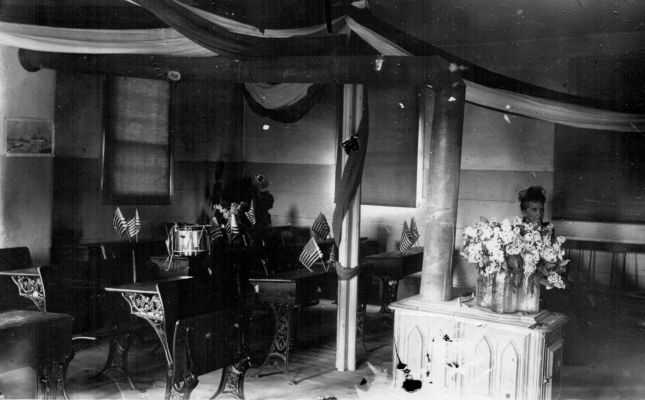
Nellie Chancey in Schoolhouse #2 on Bedford Road
We didn't know what patriotic occasion warranted flags, bunting and flowers on the woodstove;
our readers told us that the flowers are lilacs for Decoration Day (now Memorial Day).
"The only credential necessary to become a District School teacher was a high school diploma. These teachers, almost always women, boarded with a family in the neighborhood. In 1883 the salary per month ranged between $19.00 and $37.50 depending on how many students they taught. The number of students ranged between four and 27.
"In 1904, my mother E. Josephine Upton (Byam) earned $28.00 per month for each of the spring, fall and winter terms at District School #2 on Bedford Road. Out of her salary she paid for her room and board and all of her personal expenses, as well as the 'extras' like things for her classroom and gifts for the children at Christmas.
"The subjects the teachers taught were reading, spelling, penmanship, arithmetic, geography and grammar. In some schools, history, composition and physiology were also taught.
"What was it like to teach at a District School? These are some of the memories I have of what my mother told me. She was up bright and early to have breakfast and walk from her boarding house with the Warrens (on Wilson Hill Road) to District School #2 on Bedford Road, carrying her lunch and books. She started the fire in the wood stove to have the school warmed up a bit before the children started to arrive.
"Keeping eight grades busy must have been a challenge, although there were not always children in each grade and probably some grades were combined for certain classes. Discipline must have been difficult to maintain because of the big age difference and the fact that some of the older students were nearly fully grown."
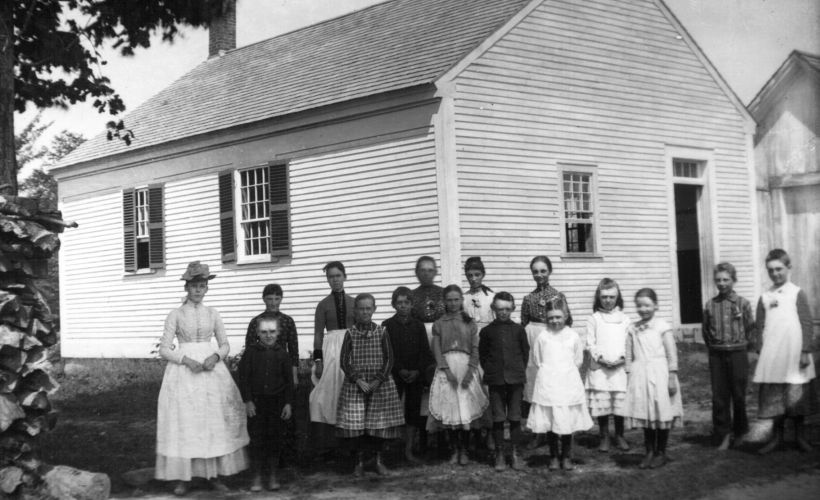
Annie Atwood was the schoolteacher at Schoolhouse #11 (Francestown Road) in 1890.
Schoolhouse #1 (Chestnut Hill School) was always a small school. In 1861 only three boys and one girl attended for one term. It was closed in 1869 and merged with a nearby Amherst school. The Chestnut Hill children returned to the New Boston school system 100 years later, in 1965.
Schoolhouse #2 (Bedford Road) had a new school house built in 1892 for $700. Seven years later a well and pump were added. On either side of the wood shed was an outhouse, one for boys and one for girls. After the last one-room schoolhouses (#2 and #13) closed in 1934, all New Boston students went to the Village School.
Schoolhouse #3 (Sevilla Jones) was named after a young woman who was shot by her jilted lover while on her way to this school in 1854. Her story may be found on the Cemetery page.
Schoolhouse #4 (Joe English) like #3 is at the base of Joe English Hill. The school and the hill are named after Joe English, a Native American who died in 1705.
Schoolhouse #9 (Wilson Hill Road) merged with #2 in 1892. Before then it had been praised for being an advanced school; in 1876 #9 was the only school house in New Boston that had a dictionary!
Schoolhouse #12 (Clark Hill Road) — a "new, pretty and commodious schoolhouse" was built here in 1872; by 1874 it had only 3 pupils.
Schoolhouse #13 (Todd's Corner) was originally on Pine Road until the new school was built on the Francestown Road in 1895.
Schoolhouse #16 (Lull Road) had as many as 55 students in 1850; the very busy teacher earned one dollar a day, plus board.
Schoolhouse #17 (Riverdale) was just over the town line in Weare. This schoolhouse is gone, but if ever you're in Riverdale you'll want to visit the nearby Red School House at the Goffstown Historical Society museum on Parker Station Road.
Why did the District Schools close?
Not all schools were in session every year. If there were not enough students in a particular area to warrant hiring a teacher, the students there were sent to the nearest available school. Gradually, schools were closed to reduce costs and children walked a little farther.
The population of New Boston declined by one third in the second half of the 19th century, as people moved away from rural New England to cities or to western states. And across the country, the one-room schoolhouse fell out of favor as reformers strove to raise standards of education. Like many towns, New Boston built a more modern Grade School in its village center.
The Village School
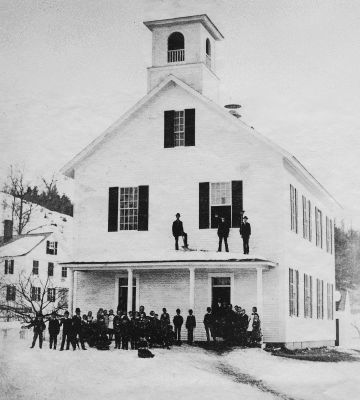
The Village School before the Fire of 1887
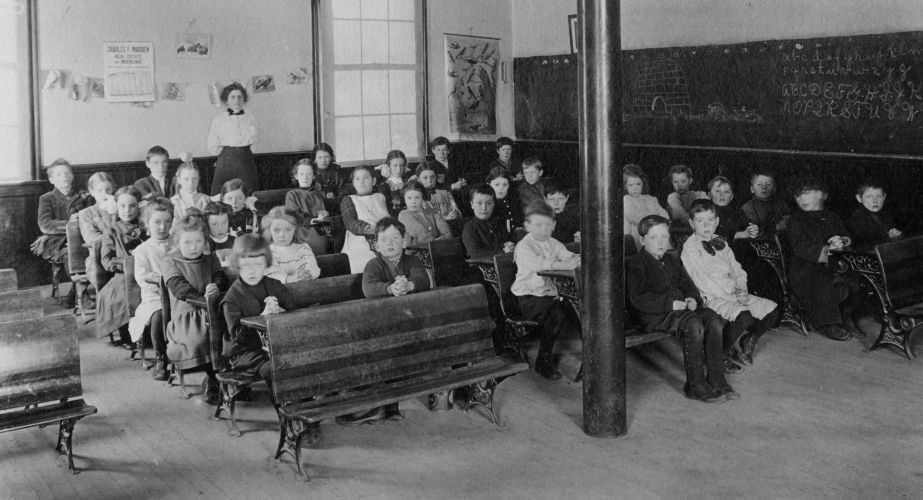
Primary school classroom in the Village School
 By the 1930s there was a school bus available to students who lived more than two miles from town. It was a panel truck with seats along the side;
Frances remembers that everyone slid down the seats when the bus stopped too quickly. High school students had to pay a fee, maybe 75 cents per week, if they wanted to ride the bus.
By the 1930s there was a school bus available to students who lived more than two miles from town. It was a panel truck with seats along the side;
Frances remembers that everyone slid down the seats when the bus stopped too quickly. High school students had to pay a fee, maybe 75 cents per week, if they wanted to ride the bus.Howard Towne and his sister Esthermary would walk from their Beard Road farm if they did not get a ride in their father's horse-drawn wagon as he delivered milk to the Creamery.
Jim Dane walked a couple of miles to the Village School. As he passed the Leland house (and telephone office) in the center of town each morning, Ginger Leland's father would tell her to "Hurry up and get ready for school - I just saw Jim Dane go by!"
The high school offered Algebra, Geometry, History, English and Grammar, Bookkeeping and Botany, as well as Latin, French, Physics and Compositions. Howard Towne told me that you could learn everything you needed for a good life in this school. He particularly enjoyed the Vocational Agriculture program that was available for boys. This course was introduced by Principal Clement A. Lyon in 1923.
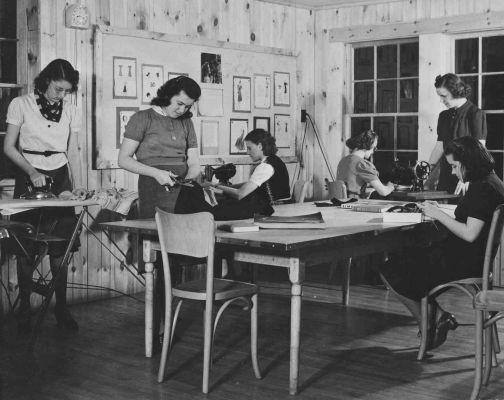 When he was in the high school "Voc Ag" program, Howard was taught by Principal Ernest Nedeau (sometimes spelled "Nadeau") about the mixing of grain for farm animals,
planting and maintaining orchards, raising vegetables, insect control, carpentry, farm machine maintenance, and blacksmith skills like welding, brazing and tempering.
When he was in the high school "Voc Ag" program, Howard was taught by Principal Ernest Nedeau (sometimes spelled "Nadeau") about the mixing of grain for farm animals,
planting and maintaining orchards, raising vegetables, insect control, carpentry, farm machine maintenance, and blacksmith skills like welding, brazing and tempering.
The headmasters had the boys work in an orchard up on Meetinghouse Hill and raise chickens in the long building that had been the Piggery for J.R. Whipple's Valley View Farm. The profits from these enterprises were used to convert the woodshed behind the school into a well-equipped workshop. During World War II, this workshop was open for New Boston farmers to repair their machinery, as parts were scarce during wartime.
Eventually someone remembered the young women of the High School and a course in Domestic Science was added in 1939. The 3rd floor of the school was refinished for this program. The ladies learned to cook and to sew while the boys were out surveying fields and playing Frisbee with cow chips.
2019 update: We found a 1939 newspaper clipping which informs us that Headmaster Ernest Nedeau supervised a woordworking class for women, too. "Articles made were tables, smoking stand, lamp, bookshelves and fruit bowls."
Frank Jones remembered that the school had a mixed chorus, a debating club, many fabulous plays, and football and baseball. A 1937 newspaper clipping described the journey of New Boston High School debaters to the National Forensic League competition in Illinois. The New Boston team became a favorite as it represented the smallest school in the contest, but it was undone when one of its principal speakers came down with tonsillitis.
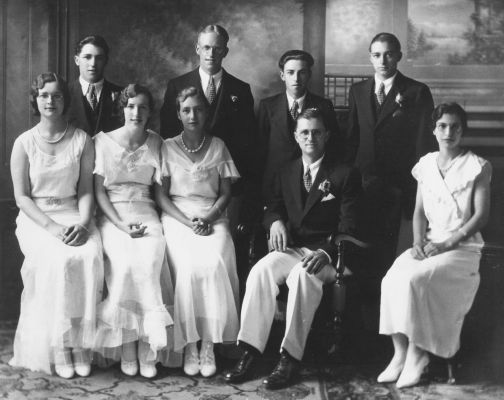
New Boston High School Class of 1932 with Principal Ernest Nedeau
Another idea was to remodel the Valley View Farm's old Cement Barn for school use, since the cows had moved out!
Since no agreement could be reached for either proposal, in 1951 a new first grade building was built on the playground. Two years later another "unit school" was built to house the second grade. These buildings are still in use today, and are sometimes referred to as "the chicken coops".
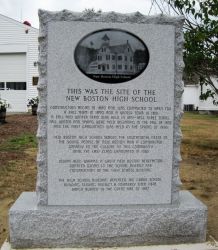 In 1955 the new Central School was built for grades 3-6 on the hill above the chicken coops. This building has been added to several times and is now a large, modern elementary school.
In 1955 the new Central School was built for grades 3-6 on the hill above the chicken coops. This building has been added to several times and is now a large, modern elementary school.
The Village School was then called New Boston High School. In 1965 the High School graduated its last class, and New Boston's older students now go to the Middle and High School in Goffstown. The New Boston High School was torn down in 1971 so that a Fire Station could be built on that location.
The Village School and later the New Boston High School were among the most important institutions of this small community for over 100 years. The decisions to close the High School and to demolish the building were not made easily or with unanimity. In 2012, the High School alumni placed a stone marker on the site of this building. (Click on the photo of the marker to see a larger image.)
A Last Look at the One-Room Schoolhouse
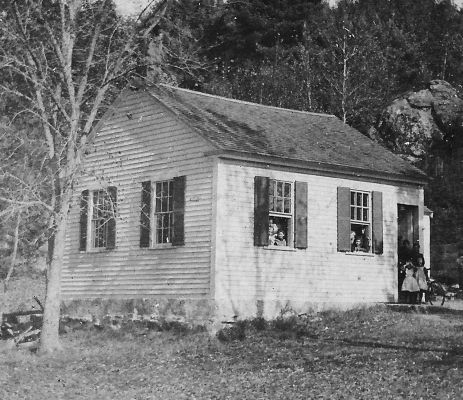
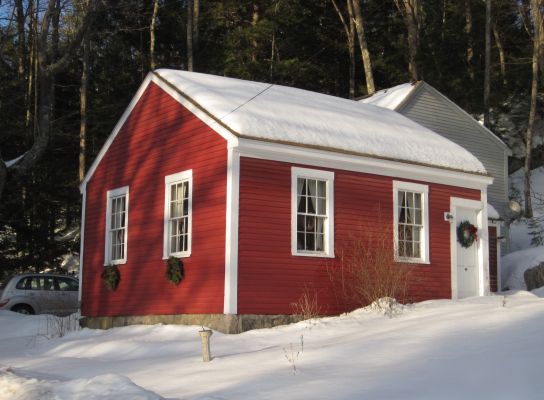
Did the teacher ride her bicycle to Schoolhouse #4? It's just visible next to the two little girls in the old photo.
If you are reading this before Saturday, June 15, 2013, you will want to sign up for the New Boston house tours which include Nonah's schoolhouse. Please do not show up at this schoolhouse with your slate and lunchpail on any other date as this is a private home.
Editor's note: I thank the New Boston Bulletin for permission to use excerpts from the wonderful "Remembering the Past" columns written by Winston Daniels and Frances & Howard Towne. -- Dan Rothman 2013
